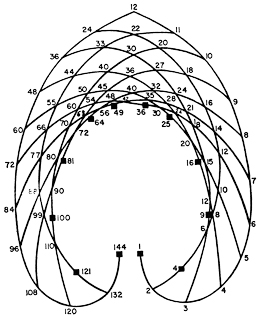THERE
MUST BE
A "RIGHT WAY"
10.09-11.11.2011

THERE MUST BE "A RIGHT WAY"
Curating François Aubart
OPENING
friday, September 9 from 6.30 pm
Exhibition by appointment, from September 10 to November 11, 2011.
MOSQUITO COAST PARTY
Concert and DJ sets : Daron hill, Nico-icon vs Saute narcisse, Splash Wave, DJ holala and Docteur Lapin.
food on spot.
Accommodation : a list of hotels and Bed & Breakfast is available here.
Booking : please make a reservation for the openning party, before september 5, 2011.
“The development of counting skills in the young child is worth close examination. Most children can count by rote to a certain number before they can count rationally. They may have learned the correct sequence of number words from other children or from grown-ups by imitation. At this stage in learning number is not connected, or is only vaguely connected, with quantity. Counting is an activity in its own right, justified by the satisfaction that the child derives from it. The sequence of words–one–two–three–four–is part of the adult world that the child strives to conquer, first by imitation and gradually through understanding.
Learning mathematics at the stage is similar to learning nursery rhymes. Like children's poetry, the spoken number sequence appeals to the child's inherent sense for rhythm, that is, the number sequence can be experienced. Here an existentialist might say that counting belongs to the realm of being and to the realm of understanding. The intellectual part of rote counting lies in the fact that number words are strictly ordered, and whenever the child muddles up the sequence, or skips a word, his older playmates or adults correct him. Thus, there must be a “right way” of saying the numbers”
Earl J. Ogletree, John A. Rackauskas et Theophil F. Buergin, « Teaching Number Sense Through Rhythmical Counting »,
The Elementary School Journal, Vol.71, No.1 (Oct. 1970), p.11
Discovering that numbers can be understood as something else than quantity should drawn us in a bottomless confusion. The fact that those abstract signs that are the base for logical and rational reasoning, can be heard only as sequences of sounds could also remind us that, elsewhere than in nursery school, we have already seen sequences of numbers becoming poems or mystical codes.
It could then be possible that the signification of a sign or of an objet change according to the way it is seen, said or described. Thus, it might be the method followed to approach it that distort what is regarded.
Trying to know something by approaching it a way that also permit to renew its signification could be the issue of this exhibition. The artworks it presents seeks ‘the right way’ to say or to show a sign, an object or a phenomenon. They were sent by mail or as instructions to be fulfilled on-site.
